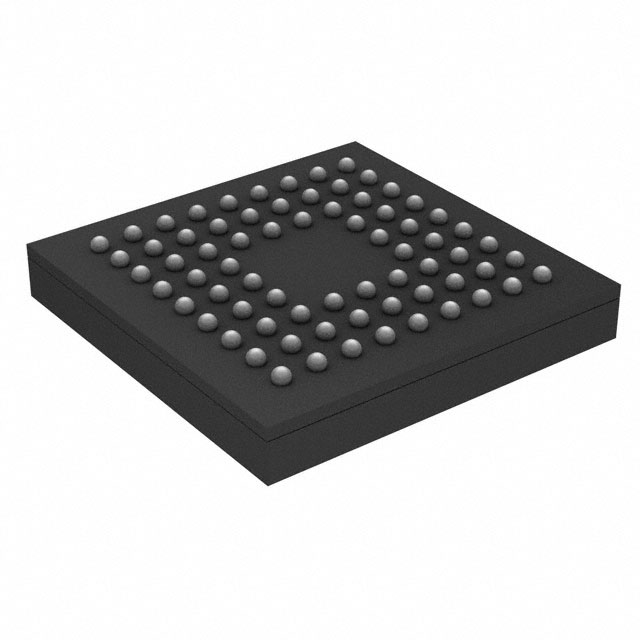THC63LVD827-B
Product Overview
Category
The THC63LVD827-B belongs to the category of high-speed LVDS (Low Voltage Differential Signaling) transmitters.
Use
This product is primarily used for transmitting high-speed digital data over long distances with low power consumption.
Characteristics
- High-speed data transmission
- Low power consumption
- Long-distance signal transmission capability
- Reliable and robust performance
Package
The THC63LVD827-B comes in a compact and industry-standard package, ensuring easy integration into various electronic systems.
Essence
The essence of THC63LVD827-B lies in its ability to provide efficient and reliable high-speed data transmission while consuming minimal power.
Packaging/Quantity
The product is typically packaged in reels or trays, with each reel or tray containing a specific quantity of THC63LVD827-B units.
Specifications
- Maximum Data Rate: 1.5 Gbps
- Supply Voltage Range: 3.0V to 3.6V
- Operating Temperature Range: -40°C to +85°C
- Output Swing: 350mV (differential)
- Power Consumption: <100mW
Detailed Pin Configuration
The THC63LVD827-B features a pin configuration as follows:
- VCC
- GND
- CLKIN
- DATAIN[0]
- DATAIN[1]
- DATAIN[2]
- DATAIN[3]
- DATAIN[4]
- DATAIN[5]
- DATAIN[6]
- DATAIN[7]
- DATAIN[8]
- DATAIN[9]
- DATAIN[10]
- DATAIN[11]
- DATAIN[12]
- DATAIN[13]
- DATAIN[14]
- DATAIN[15]
- CLKSEL
- OE
Functional Features
- High-speed LVDS data transmission
- Clock signal selection capability
- Output enable/disable control
Advantages and Disadvantages
Advantages
- High-speed data transmission capability enables efficient communication.
- Low power consumption makes it suitable for battery-powered devices.
- Long-distance signal transmission capability allows for flexible system design.
Disadvantages
- Requires additional components for complete LVDS communication system implementation.
- Limited compatibility with non-LVDS systems.
Working Principles
The THC63LVD827-B operates on the principle of LVDS, which uses a differential signaling scheme to transmit digital data. It converts parallel data inputs into high-speed serial data streams, which are then transmitted differentially over a twisted-pair cable. This differential signaling reduces noise susceptibility and enables reliable long-distance data transmission.
Detailed Application Field Plans
The THC63LVD827-B finds applications in various fields, including:
- Automotive: Used in infotainment systems, driver assistance systems, and automotive displays.
- Industrial: Employed in factory automation, robotics, and control systems.
- Medical: Utilized in medical imaging equipment and patient monitoring devices.
- Communication: Integrated into high-speed data communication systems and network infrastructure.
Detailed and Complete Alternative Models
- THC63LVD827-A: Similar to THC63LVD827-B but with a lower maximum data rate of 1.0 Gbps.
- THC63LVD828: A dual-channel LVDS transmitter with enhanced features and higher data rate capabilities.
(Note: The above alternative models are provided for reference purposes and may have different specifications and pin configurations.)
In conclusion, the THC63LVD827-B is a high-speed LVDS transmitter that offers efficient and reliable data transmission while consuming minimal power. Its compact package and versatile applications make it a suitable choice for various industries.
قم بإدراج 10 أسئلة وإجابات شائعة تتعلق بتطبيق THC63LVD827-B في الحلول التقنية
Sure! Here are 10 common questions and answers related to the application of THC63LVD827-B in technical solutions:
Q: What is THC63LVD827-B? A: THC63LVD827-B is a high-speed LVDS (Low Voltage Differential Signaling) serializer/deserializer (SerDes) chip used for transmitting and receiving data over long distances.
Q: What are the key features of THC63LVD827-B? A: The key features of THC63LVD827-B include high-speed data transmission up to 1.5 Gbps, low power consumption, built-in ESD protection, and compatibility with LVDS standards.
Q: In what applications can THC63LVD827-B be used? A: THC63LVD827-B is commonly used in various applications such as automotive infotainment systems, industrial automation, medical equipment, and high-speed communication interfaces.
Q: How does THC63LVD827-B achieve long-distance data transmission? A: THC63LVD827-B uses LVDS technology, which employs differential signaling to reduce noise and provide robust data transmission over long distances.
Q: Can THC63LVD827-B be used for bidirectional communication? A: Yes, THC63LVD827-B supports both serializing (transmitting) and deserializing (receiving) functions, making it suitable for bidirectional communication.
Q: What is the power supply voltage range for THC63LVD827-B? A: THC63LVD827-B operates on a power supply voltage range of 3.0V to 3.6V.
Q: Does THC63LVD827-B support hot-plugging capability? A: Yes, THC63LVD827-B is designed to support hot-plugging, allowing for easy and convenient connection/disconnection of devices without causing damage.
Q: Can THC63LVD827-B be used in harsh environments? A: Yes, THC63LVD827-B is designed to operate reliably in harsh environments, with a wide operating temperature range and built-in ESD protection.
Q: What is the maximum cable length supported by THC63LVD827-B? A: The maximum cable length supported by THC63LVD827-B depends on various factors such as data rate, cable quality, and noise conditions. However, it can typically support distances up to several meters.
Q: Are there any evaluation boards or reference designs available for THC63LVD827-B? A: Yes, Toshiba provides evaluation boards and reference designs for THC63LVD827-B, which can help developers quickly prototype and integrate the chip into their applications.
Please note that these answers are general and may vary depending on specific application requirements and implementation details.


